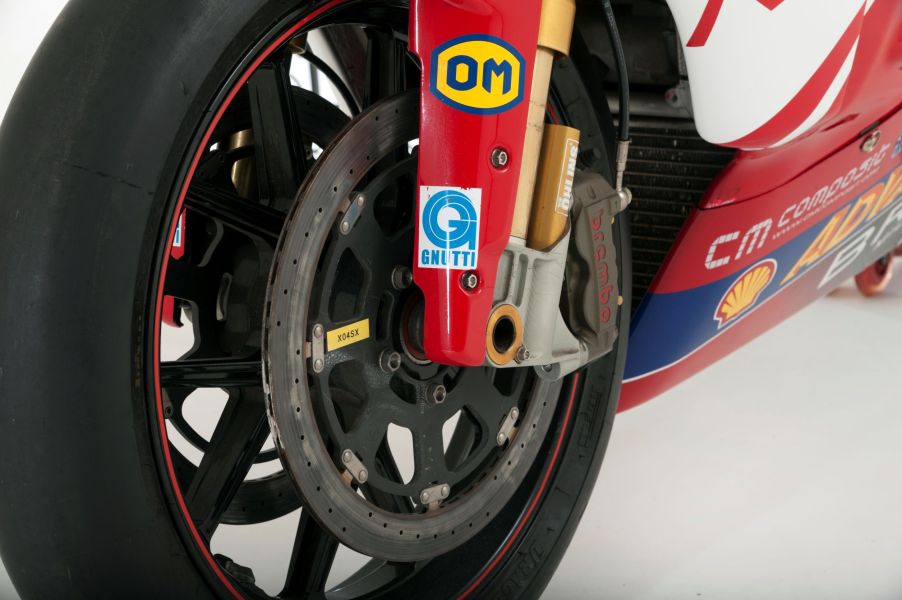
Would Your Motorcycle Benefit From an Inverted Fork?
All the horsepower in the world doesn’t matter if your motorcycle’s suspension isn’t properly set up. So, as in the car world, suspension modifications are common even on bikes that don’t zoom around racetracks. One of these mods is swapping out the motorcycle’s existing fork for an inverted fork. But is it something you should do on your bike?
How do motorcycle forks work?

While a motorcycle’s rear shock(s) looks fairly similar to what cars use, motorcycle forks seem to be a different matter. But that’s only on the outside. On a basic level, a motorcycle fork has the same components as a car’s coilover. It’s just that some of a coilover’s external components are internal fork parts.
Inside the fork tube is a long damping rod with a piston at one end that passes through a fluid-and-gas-filled cartridge. In other words, a shock absorber. The piston isn’t solid metal, though; it’s comprised of a stack of washers and a ring of holes, Cycle World explains. And some cartridges also contain secondary valve assemblies. At its other end, the rod is attached to the main body of the motorcycle fork and surrounded by a metal spring assembly. Or, with some modern forks, air springs or electronic assemblies.
This whole fork assembly is attached not just to the front wheel, but also the frame via triple clamps, Motorcycle Cruiser says. The bike’s handlebars are attached to the top triple clamp (or to the fork itself in clip-on bars’ case), which pivots to let you steer.
That spring assembly supports the weight of the bike and absorbs impacts from road imperfections, Bennetts explains. This keeps the tire in contact with the road as much as possible to maintain traction for cornering, accelerating, and braking, Motofomo says. However, if the motorcycle fork only used springs, even minor bumps would bounce you up and down for a long time. If you’ve ever ridden in a car with blown shocks, you know the feeling.
That’s where the shock absorber comes in. When the spring moves, it also moves the piston. And the resistance of the fluid passing through the holes keeps the spring’s movement controlled, i.e., dampened. Adjustable motorcycle forks let riders change how the fluid moves through the piston’s holes to tweak the fork’s behavior.
What is an inverted fork?

But that’s how a ‘conventional’ motorcycle fork works. What makes an inverted fork, aka an ‘upside-down fork’ or ‘USD fork’ different?
Mechanically, nothing, Motorcyclist says. An inverted fork works the same way as a conventional motorcycle fork. And broadly speaking, they use the same parts. But there is a difference: orientation.
Conventional motorcycle forks put their sliders—the wider outer part of the fork assembly—at the front wheel axle. USD forks, meanwhile, put their stanchions—the skinnier inner tube—there. Hence why they’re called ‘inverted’ or ‘upside-down’ forks.
Are inverted forks better than conventional motorcycle forks?
Being upside-down relative to conventional motorcycle forks does make inverted forks harder to service, RevZilla reports. And if the fork seal brakes, more oil leaks out than if your bike had a conventional fork. But USD forks have several notable benefits over conventional ones.
Firstly, a motorcycle fork effectively acts like a big lever under braking and cornering. This creates a significant amount of bending force, concentrated significantly around the top triple clamp. That means steering and suspension flex, which is bad for handling, steering feedback, and rider confidence.
However, the wider you make the fork tubes, the stiffer and more resistant to flexing they become. Because inverted forks have wider sections up top, they flex less than conventional ones. And upside-down forks’ sliders are often longer than ones on conventional forks, adding further anti-bending support, Motorcyclist says.
Also, putting the slider up top rather than at the wheel reduces unsprung mass. This makes it easier for the fork to do its job and typically improves handling and steering feel. Plus, it often translates to better and faster cornering.
Finally, while inverted forks are often identical to their conventional counterparts, that’s not always the case. Some cheap conventional motorcycle forks use a cruder damper-rod assembly rather than a cartridge like most upside-down forks, Motorcyclist reports. Even if they’re not adjustable or upside-down, cartridge forks are better than damper-rod ones.
How much does it cost to install one on your bike?

Because inverted forks offer so many positive benefits, they’ve become standard equipment on many sporty bikes. My 2012 Triumph Street Triple R, for example, has adjustable upside-down Kayaba forks. So does the brand-new Yamaha YZF-R7 sportbike. But while the Indian FTR has upside-down forks, the Scout cruiser doesn’t. And because inverted forks only started being used in racing in the late ‘80s, most classic motorcycles lack them, too.
However, that doesn’t mean you can’t give an inverted fork to a bike without one. It’s just not necessarily easy. And it requires keeping your bike’s steering geometry, weight, wheels, brakes, head stem, and handlebars in mind. For that reason, the simplest way to do it is to buy an entire front end—fork, brakes, axle, wheel, and all, Purpose Built Moto says.
Fortunately for classic owners, USD conversion kits do exist. And depending on your modern bike’s make and model, some aftermarket solutions might be available. K-Tech, for example, makes a USD racing fork for the Scout Bobber. And the Kraus Motor Company has conversion kits for new and old Harleys. However, the Kraus Dyanamoto SP kit starts at just under $5100.
So, should you install this kind of fork on your bike if it doesn’t come as standard? If you’re racing it, yes. But for most road riders, rebuilding and refreshing their existing forks is a better use of money.
Follow more updates from MotorBiscuit on our Facebook page.


